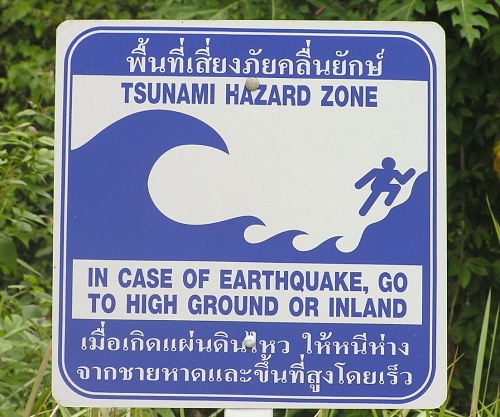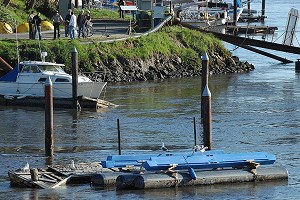
Photo courtesy Bruce Manchon, all rights reserved
That refers to an earthquake that you feel, not one you hear about on the radio. I can be a little more specific. Don’t worry about small earthquakes, namely the short, sharp shocks we feel often around here. Worry about a long-lasting earthquake, one with slow rhythms. If one of those happens while you’re at the beach, look—you want to leave anyway, because a large earthquake like that may mean trouble at home. If the sea starts acting strange, do what the sign says, period. Otherwise, follow your usual earthquake protocol: Get away without dawdling, drive warily with your radio on, remember your family plan, use your phone no more than absolutely necessary.
The tsunamis that arrive from distant quakes, or teletsunamis, come with several hours of warning. The nearest earthquake faults that could send a damaging tsunami our way—subduction zones—are off northernmost California, part of the Cascadia seismic zone that stretches up the Oregon and Washington coast into Canada. A tsunami arising from a magnitude-8 or larger event up there would arrive here at least a couple hours later. Tsunamis from major earthquakes in Alaska, far eastern Russia, Japan and the Philippines will give us much longer warning times. There are enough people on a typical beach, with phones and text devices and radios, that you should be able to count on sufficient warning even for a Cascadia event. In addition, local emergency responders will be out in person to warn beachgoers. (If you’re on the beach alone, be more alert.)
If you hear about an approaching tsunami, I must advise you: don’t be irresponsible and rush to the beach. We’re all intrigued by geological phenomena, and every red-blooded geologist has “witness a tsunami” on his or her geological bucket list. But remember the person taking pictures at Crescent City (a town also ravaged by a tsunami from the 1964 Alaska earthquake) who was washed out to sea. Think about the surfers who wandered around Santa Cruz Harbor, risking themselves and worrying others, as the waters rushed in and out.
However, if you choose to ignore my advice, then you should do as I wish I could have done, and proceed in a responsible manner to a safe place high above the water, obeying authorities, not congesting emergency escape routes, prepared for the worst. UC Santa Cruz geologist Christie Rowe did that and recorded the tsunami’s arrival. She adds, “I would advise people not to panic, to check the West Coast Tsunami Warning Center website and select a vantage point well above the predicted wave height.”
But not every tsunami is a seismic tsunami. Two other kinds of tsunamis, not monitored by dedicated networks, have a chance of happening somewhere in the world during the average lifetime: landslide and impact tsunamis. A landslide tsunami, caused by large mass movements into or beneath the sea, is quite plausible along our steep coasts and rugged offshore seafloors. Be wary of one even after a relatively small local quake. An impact tsunami, caused by an object from space crashing into the ocean, has no upper size limit and no preferred location. The odds are small but every beach in the world, ours included, faces the risk. So be like a sailor and always keep your weather eye out.
Learn more:
California tsunami information
National Tsunami Awareness Week
tsunami.gov
West Coast/Alaska Tsunami Warning Center
36.9590 -122.0226
 The tsunami of March 11 broke docks and damaged boats in Santa Cruz Harbor. Most earthquake-generated tsunamis in this part of California will cause similar levels of damage. Photo courtesy Sequoia Hughes of Flickr under Creative Commons license.
The tsunami of March 11 broke docks and damaged boats in Santa Cruz Harbor. Most earthquake-generated tsunamis in this part of California will cause similar levels of damage. Photo courtesy Sequoia Hughes of Flickr under Creative Commons license.
